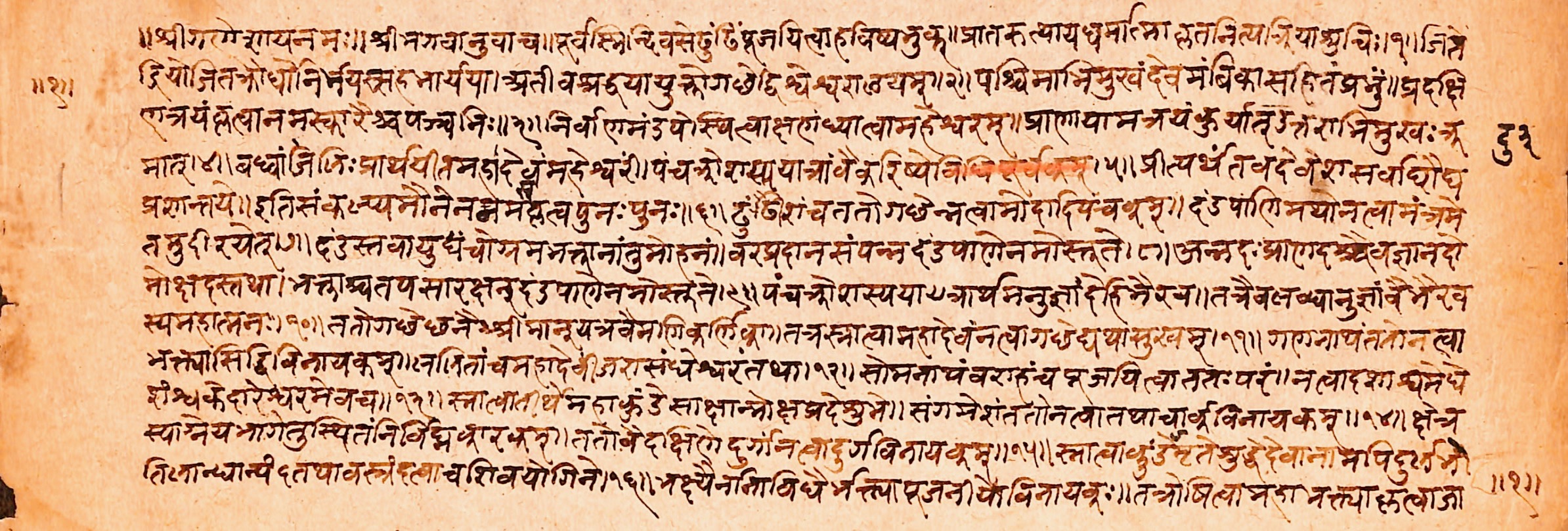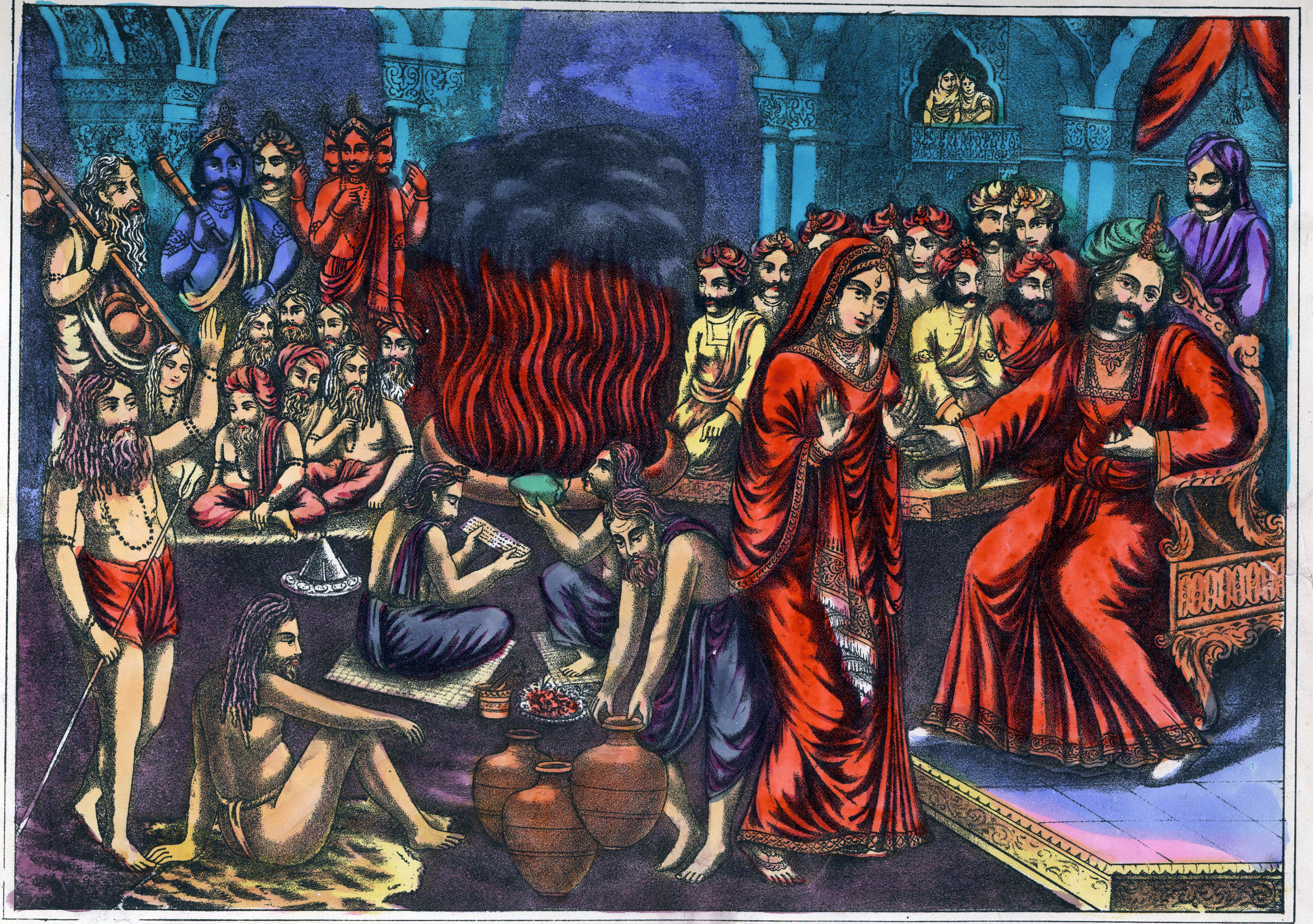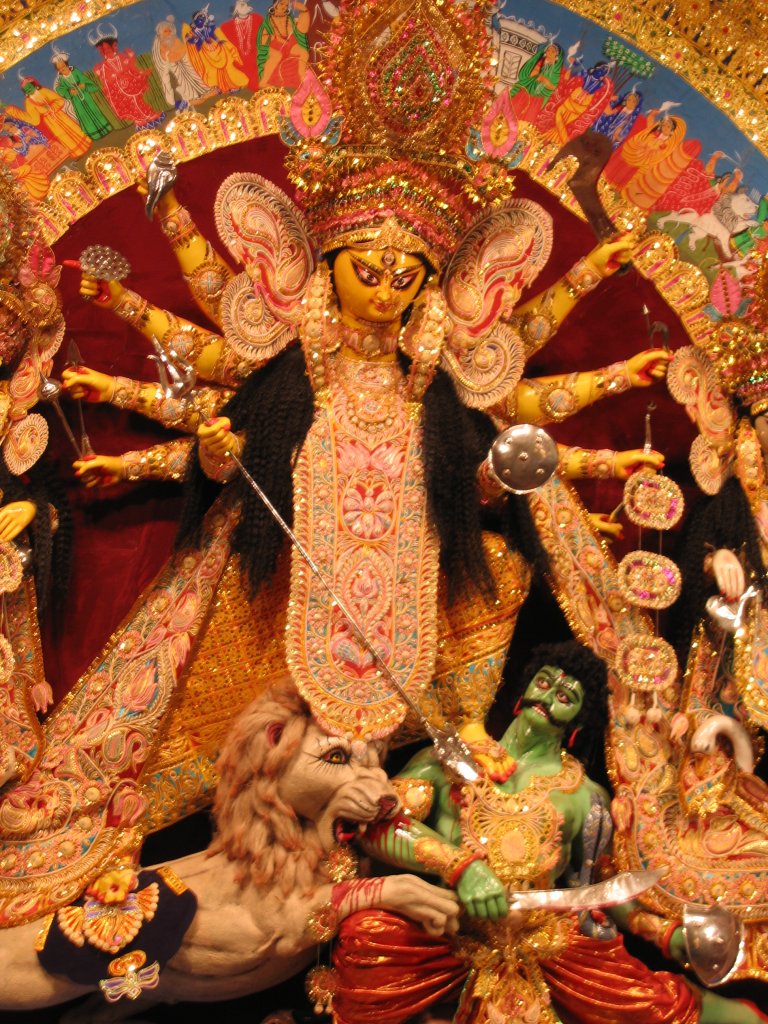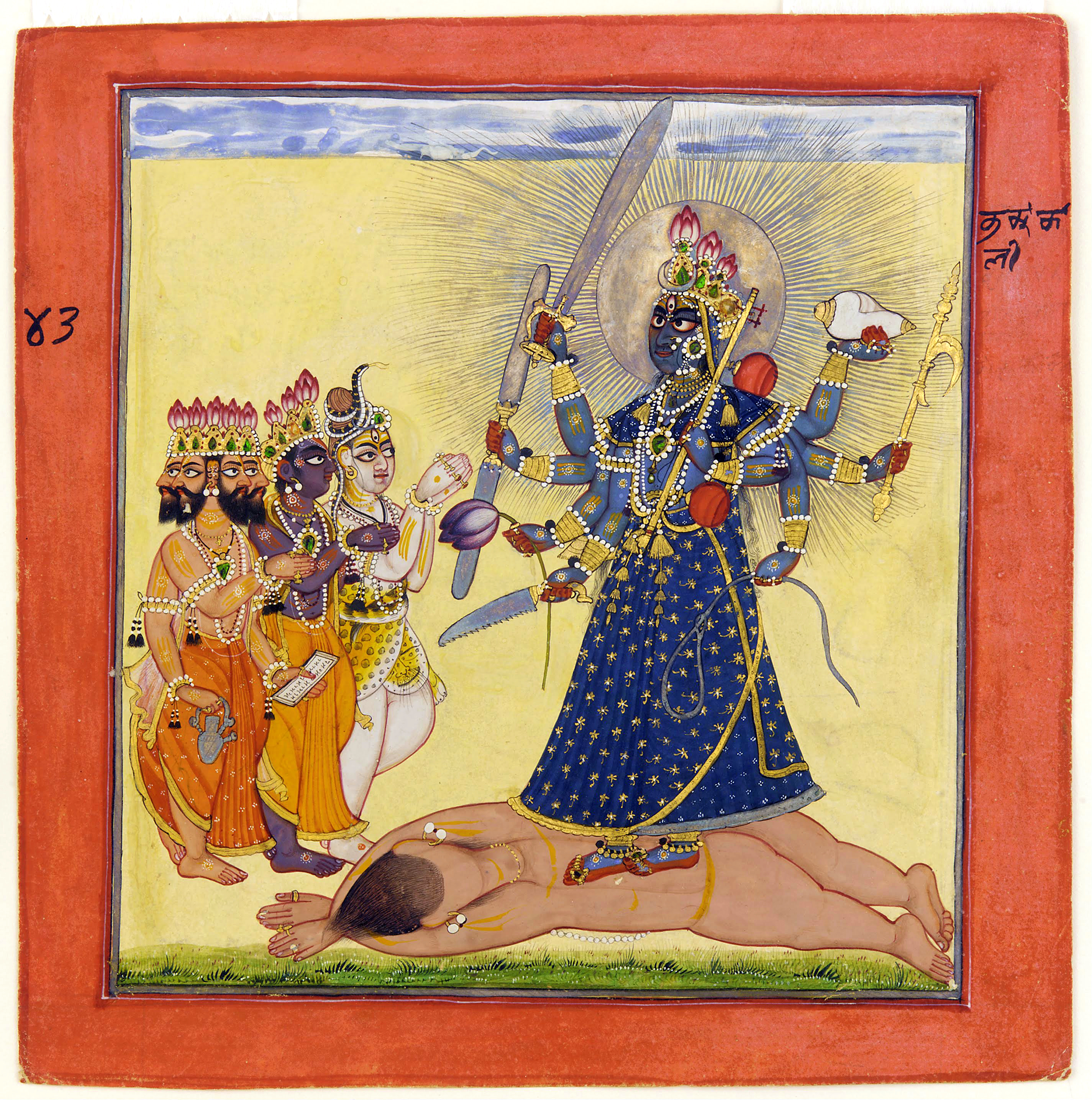|
Twarita
Tvarita () is a goddess primarily featured in Tantric Hinduism. She is depicted to be a member of the group of nine yoginis called the nityas, and an aspect of Adi Parashakti. Iconography Tvarita is depicted to be dark-complexioned. She has a crown on her head, which contains a peacock's tail. Her garments are made of leaves. She wears a necklace that is made of gunja flowers (rosary pea). The hem of her cloth, which is made of eight snakes, hangs down to the weight of her breasts. She is decked with armlets, a waist-chain, and anklets. She has three eyes, and has a fierce appearance. On one of her hands, she performs a gesture called the varada mudra, and on the other, the abhaya mudra. Legend In her early sources, Tvarita is depicted to be a goddess who was best known for saving the lives of the victims of snakebites. She was eventually assimilated and identified with the goddesses of Durga and Kali. Tvarita is conceived as a tribal woman with garments of leaves, peacock ... [...More Info...] [...Related Items...] OR: [Wikipedia] [Google] [Baidu] |
Shaktism
Shaktism ( sa, शाक्त, , ) is one of several major Hindu denominations, wherein the metaphysical reality is considered metaphorically a woman and Shakti ( Mahadevi) is regarded as the supreme godhead. It includes many goddesses, all considered aspects of the same supreme goddess. Shaktism has different sub-traditions, ranging from those focused on most worshipped Durga, gracious Parvati to that of fierce Kali. The Sruti and Smriti texts of Hinduism are an important historical framework of the Shaktism tradition. In addition, it reveres the texts '' Devi Mahatmya'', the ''Devi-Bhagavata Purana'', '' Kalika Purana'' and Shakta Upanishads such as the Devi Upanishad. The ''Devi Mahatmya'' in particular, is considered in Shaktism to be as important as the '' Bhagavad Gita''. Shaktism is known for its various sub-traditions of tantra, as well as a galaxy of goddesses with respective systems. It consists of the Vidyapitha and Kulamārga. The pantheon of goddesses in S ... [...More Info...] [...Related Items...] OR: [Wikipedia] [Google] [Baidu] |
Asura
Asuras (Sanskrit: असुर) are a class of beings in Indian religions, Indic religions. They are described as power-seeking clans related to the more benevolent Deva (Hinduism), Devas (also known as Suras) in Hinduism. In its Buddhism, Buddhist context, the word is sometimes translated "Titan (mythology), titan", "demigod", or "antigod". According to Hindu texts, Hindu scriptures, the asuras are in constant battle with the devas. Asuras are described in Indian texts as powerful superhuman demigods with good or bad qualities. In early Vedic literature, the good Asuras are called ''Adityas'' and are led by Varuna, while the malevolent ones are called ''Danava (Hinduism), Danavas'' and are led by Vritra. In the earliest layer of Vedic texts Agni, Indra and other gods are also called Asuras, in the sense of their being "lords" of their respective domains, knowledge and abilities. In later Vedic and post-Vedic texts, the benevolent gods are call ... [...More Info...] [...Related Items...] OR: [Wikipedia] [Google] [Baidu] |
Agni Purana
The ''Agni Purana'', ( sa, अग्नि पुराण, ) is a Sanskrit text and one of the eighteen major Puranas of Hinduism. The text is variously classified as a Purana related to Shaivism, Vaishnavism, Shaktism and Smartism, but also considered as a text that covers them all impartially without leaning towards a particular theology. The text exists in numerous versions, some very different from others. The published manuscripts are divided into 382 or 383 chapters, containing between 12,000 and 15,000 verses. The chapters of the text were likely composed in different centuries, with earliest version probably after the 7th-century,Thomas Green (2001). ''Martial Arts of the World: An Encyclopedia'', ABC-CLIO, , page 282 but before the 11th century because the early 11th-century Persian scholar Al-Biruni acknowledged its existence in his memoir on India. The youngest layer of the text in the ''Agni Purana'' may be from the 17th century. The ''Agni Purana'' is a medieval er ... [...More Info...] [...Related Items...] OR: [Wikipedia] [Google] [Baidu] |
Daksha Yajna
Dakṣayajña is an important event in Hindu mythology that is narrated in various Hindu scriptures. It refers to a yajna (ritual-sacrifice) organised by Daksha, where his daughter, Sati, immolates herself. The wrath of the god Shiva, Sati's husband, thereafter destroys the sacrificial ceremony. The tale is also called Daksha-Yajna-Nasha ("destruction of Daksha's sacrifice). The legend forms the liturgical basis of the establishment of the Shakti Pithas, the temples of Mahadevi, the supreme deity of Shaktism. It is also becomes a prelude to the legend of Parvati, Sati's reincarnation, who later marries Shiva. The tale is mainly told in the ''Vayu Purana''. It is also mentioned in the ''Kasi Kanda'' of the ''Skanda Purana'', the ''Kurma Purana'', ''Harivamsa Purana,'' and the ''Padma Purana''. The ''Linga Purana'', ''Shiva Purana'', and ''Matsya Purana'' also detail the incident. Variations of the legend may be observed in later Puranas, each text lending a superior account to the ... [...More Info...] [...Related Items...] OR: [Wikipedia] [Google] [Baidu] |
Virabhadra
Virabhadra (), also rendered Veerabhadra, Veerabathira, and Veerabathiran, is a fierce form of the Hindu god Shiva. He is created by the wrath of Shiva, when the deity hurls a lock of his matted hair upon the ground, upon hearing of the self-immolation of his consort, Sati, at the Daksha yajna.the Horse-sacrifice of the Prajapati Daksha translated by Kisari Mohan Ganguli (1883–1896), Book 12: Santi Parva: Mokshadharma Parva: Section CCLXXXIV. p. 315 Mahadeva created from his mouth a terrible Being whose very sight could make one's hair stand on its end. The blazing flames th ... [...More Info...] [...Related Items...] OR: [Wikipedia] [Google] [Baidu] |
Vaishno Devi
Vaishno Devi (also known as Mata Rani, Trikuta, Ambe and Vaishnavi) is a manifestation of the Hindu Mother Goddess, Durga or Adi Shakti. The words "''Maa''" and "''Mata''" are commonly used in India for ''mother'', and thus are often heavily used in connection with Vaishno Devi. Vaishnavi took avatar from the combined energies of Mahakali, Mahalakshmi, and Mahasaraswati. The temple is located in Katra, India. Legend Author Abha Chauhan identifies Vaishno Devi with the power of Vishnu as well as the incarnation of Lakshmi. Author Pintchman identifies with great goddess Mahadevi and says Vaishno Devi contains all powers and is associated with the entire creation as Mahadevi. Pintchman further states that, "Pilgrims identify Vaishno Devi with Durga whom North Indians (and others) also name ''Sheranwali'', "the Lion-rider" more than with any other goddess". Origin According to Devi Bhagavata Purana, she is mentioned as Rudrasundari on Trikuta. In Varaha Purana, she originate ... [...More Info...] [...Related Items...] OR: [Wikipedia] [Google] [Baidu] |
Chamunda
Chamunda (Sanskrit: चामुण्डा, ISO-15919: Cāmuṇḍā), also known as Chamundeshwari, Chamundi or Charchika, is a fearsome form of Chandi, the Hindu Divine Mother Shakti and is one of the seven Matrikas (mother goddesses).Wangu p.72 She is also one of the chief Yoginis, a group of sixty-four or eighty-one Tantric goddesses, who are attendants of the warrior goddess Parvati.Wangu p.114 The name is a combination of Chanda and Munda, two monsters whom Chamunda killed. She is closely associated with Kali, another fierce aspect of Parvati. She is identified with goddesses Parvati, Kali or Durga. The goddess is often portrayed as residing in cremation grounds or around holy fig trees. The goddess is worshipped by ritual animal sacrifices along with offerings of wine. The practice of animal sacrifices has become less common with Shaivite and Vaishnavite influences. Origins Ramakrishna Gopal Bhandarkar says that Chamunda was originally a tribal goddess, worshipp ... [...More Info...] [...Related Items...] OR: [Wikipedia] [Google] [Baidu] |
Katyayani
''Katyayani'' (कात्यायनी) is an aspect of Mahadevi and the slayer of the tyrannical demon Mahishasura. She is the sixth among the Navadurgas, the nine forms of Hindu goddess Durga who are worshipped during the festival of Navaratri. She is depicted with four, ten or eighteen hands. This is the second name given for Goddess Adi Parashakti in Amarakosha, the Sanskrit lexicon (Goddess Parvati names- Uma, Katyayani, Gauri, Kali, Haimavati, Ishwari). In Shaktism, she is associated with the fierce forms of Shakti or Durga, a warrior goddess, which also includes Bhadrakali and Chandika, and traditionally she is associated with the colour red, as with Goddess Parvati, the primordial form of Shakti, a fact also mentioned in Patanjali's Mahabhashya on Pāṇini, written in 2nd century BCE. She is first mentioned in the Taittiriya Aranyaka part of the Yajurveda. Skanda Purana mentions her being created out of the spontaneous anger of Gods, which eventually led to slay ... [...More Info...] [...Related Items...] OR: [Wikipedia] [Google] [Baidu] |
Bhadrakali
Bhadrakali (IAST: Bhadrakālī; ), also known as Mahakali and Kali, is a Hindu goddess. According to Shaktism, she is one of the fierce forms of the Supreme Goddess Shakti, or Adi Parashakti, mentioned in the Devi Mahatmyam. In Vaishnavism, Bhadrakali is among the many epithets of Yogamaya, the internal potency of illusion of the preserver deity, Vishnu. According to several Puranas, Bhadrakali is a form of the goddess Parvati. She is worshipped in Kerala as Bhagavati, Mahakali, Chamunda, Sree Kurumba, and Kariam Kali Murti. She is purported to be the auspicious and fortunate form of Mahakali who protects the good, known as Bhadra. Etymology In Sanskrit, ''Bhadra'' means ''auspicious.'' Another interpretation of this name is that ''Bhadra'' comes from 'Bha' and 'dra', The letter 'Bha' means 'delusion' or 'Maya'and 'dra' is used as a superlative i.e. meaning 'the most/the greatest etc.' which makes the meaning of Bhadra as ''Maha Maya''. In other words, maya represents th ... [...More Info...] [...Related Items...] OR: [Wikipedia] [Google] [Baidu] |
Shiva Purana
The ''Shiva Purana'' is one of eighteen major texts of the ''Purana'' genre of Sanskrit texts in Hinduism, and part of the Shaivism literature corpus. It primarily revolves around the Hindu god Shiva and goddess Parvati, but references and reveres all gods. The ''Shiva Purana'' asserts that it once consisted of 100,000 verses set out in twelve Samhitas (Books), however the Purana adds that it was abridged by Sage Vyasa before being taught to Romaharshana. The surviving manuscripts exist in many different versions and content, with one major version with seven books (traced to South India), another with six books, while the third version traced to the medieval Bengal region of the Indian subcontinent with no books but two large sections called ''Purva-Khanda'' (Previous Section) and ''Uttara-Khanda'' (Later Section). The two versions that include books, title some of the books same and others differently. The Shiva Purana, like other Puranas in Hindu literature, was likely a liv ... [...More Info...] [...Related Items...] OR: [Wikipedia] [Google] [Baidu] |
Sri Yantra
The Sri Yantra, Shri Yantra, or Shri Chakra is a form of mystical diagram (''yantra'') used in the Shri Vidya school of Hinduism. It consists of nine interlocking triangles - four upward ones which represent Shiva, and five downward ones representing Shakti. All these surround the central point, the ''bindu''. These triangles represent the cosmos and the human body. Because of its nine triangles, Shri Yantra is also known as the ''Navayoni Chakra''. When the two-dimensional Shri Yantra is represented in three dimensions, it is called a ''Mahameru''. Mount Meru derives its name from this shape. In addition to Mount Meru, all other yantras derive from the Shri Yantra. Appearance In the 2009 issue of Brahmavidya (the journal of the Adyar Library), Subhash Kak argues that the description of Shri Yantra is identical to the ''yantra'' described in the Śrī Sūkta in the Rigveda. The Sri Yantra's 9 constituent triangles vary in size and shape and intersect to form 43 smaller triangles ... [...More Info...] [...Related Items...] OR: [Wikipedia] [Google] [Baidu] |
Tripura Sundari
Tripura Sundari (Sanskrit: त्रिपुरा सुन्दरी, IAST: Tripura Sundarī), also known as Rajarajeshwari, Shodashi, Kamakshi, and Lalita is a Hindu goddess, worshipped as a principal aspect of supreme goddess Mahadevi mainly venerated in Shaktism, the goddess-oriented sect of Hinduism. She is also one of the ten Mahavidyas. She is praised in many Shakta texts, with '' Lalita Sahasranama, Soundarya Lahari'' being the most popular one. She is known as Adi Parashakti in Lalitopakhyana of Brahmanda Purana. According to the Srikula tradition in Shaktism, Tripura Sundari is the foremost of the Mahavidyas, the supreme divinity of Hinduism and also the primary goddess of Sri Vidya. The Tripura Upanishad places her as the ultimate Shakti (energy, power) of the universe. She is described as the supreme consciousness, ruling from above Brahma, Vishnu, and Shiva. Kinsley says, "In one instance she is said to be sitting on Shiva's lap in the Kameshwara form, the 'Lor ... [...More Info...] [...Related Items...] OR: [Wikipedia] [Google] [Baidu] |









%2C_folio_3_from_the_Shiva_Purana%2C_c._1828.jpg)
